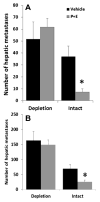Reducing liver metastases of colon cancer in the context of extensive and minor surgeries through β-adrenoceptors blockade and COX2 inhibition
- PMID: 27235931
- PMCID: PMC5497122
- DOI: 10.1016/j.bbi.2016.05.017
Reducing liver metastases of colon cancer in the context of extensive and minor surgeries through β-adrenoceptors blockade and COX2 inhibition
Abstract
Liver metastases are a major cause of colorectal cancer death, and the perioperative period is believed to critically affect the metastatic process. Here we tested whether blocking excess release of catecholamines and prostaglandins during surgical procedures of different extent can reduce experimental liver metastasis of the syngeneic CT26 colon cancer in female and male BALB/c mice. Animals were either treated with the beta-blocker, propranolol, the COX-2 inhibitor, etodolac, both drugs, or vehicle. The role of NK cells in controlling CT26 hepatic metastasis and in mediating the effect of the drugs was assessed by in vivo depletion or stimulation of NK cells, using anti-asialo GM1 or CpG-C, respectively. Surgical extent was manipulated by adding laparotomy to small incision, extending surgical duration, and enabling hypothermia. The results indicated that combined administration of propranolol and etodolac, but neither drug alone, significantly improved host resistance to metastasis. These beneficial effects occurred in both minor and extensive surgeries, in both sexes, and in two tumor inoculation approaches. NK cell-mediated anti-CT26 activity is involved in mediating the beneficial effects of the drugs. Specifically, CpG-C treatment, known to profoundly activate mice marginating-hepatic NK cytotoxicity, reduced CT26 hepatic metastases; and NK-depletion increased metastases and prevented the beneficial effects of the drugs. Overall, given prevalent perioperative psychological and physiological stress responses in patients, and ample prostaglandin release by colorectal tumors and injured tissue, propranolol and etodolac could be tested clinically in laparoscopic and open colorectal surgeries, attempting to reduce patients' metastatic disease.
Keywords: COX-2 inhibition; CT26 colon-cancer; Colorectal cancer; Etodolac; Liver metastasis; Peri-operative period; Propranolol; β-Adrenergic blocker.
Copyright © 2016 Elsevier Inc. All rights reserved.
Figures





Similar articles
-
Improving survival rates in two models of spontaneous postoperative metastasis in mice by combined administration of a beta-adrenergic antagonist and a cyclooxygenase-2 inhibitor.J Immunol. 2010 Mar 1;184(5):2449-57. doi: 10.4049/jimmunol.0903301. Epub 2010 Feb 1. J Immunol. 2010. PMID: 20124103
-
Perioperative inhibition of β-adrenergic and COX2 signaling in a clinical trial in breast cancer patients improves tumor Ki-67 expression, serum cytokine levels, and PBMCs transcriptome.Brain Behav Immun. 2018 Oct;73:294-309. doi: 10.1016/j.bbi.2018.05.014. Epub 2018 May 22. Brain Behav Immun. 2018. PMID: 29800703 Clinical Trial.
-
Stress impairs the efficacy of immune stimulation by CpG-C: Potential neuroendocrine mediating mechanisms and significance to tumor metastasis and the perioperative period.Brain Behav Immun. 2016 Aug;56:209-220. doi: 10.1016/j.bbi.2016.02.025. Epub 2016 Mar 2. Brain Behav Immun. 2016. PMID: 26944000 Free PMC article.
-
Perioperative biobehavioral interventions to prevent cancer recurrence through combined inhibition of β-adrenergic and cyclooxygenase 2 signaling.Cancer. 2019 Jan 1;125(1):45-56. doi: 10.1002/cncr.31594. Epub 2018 Oct 6. Cancer. 2019. PMID: 30291805 Free PMC article. Review.
-
Surgical stress response and promotion of metastasis in colorectal cancer: a complex and heterogeneous process.Clin Exp Metastasis. 2018 Apr;35(4):333-345. doi: 10.1007/s10585-018-9873-2. Epub 2018 Jan 15. Clin Exp Metastasis. 2018. PMID: 29335811 Review.
Cited by
-
Angiotensin II subtype 1a receptor signaling in resident hepatic macrophages induces liver metastasis formation.Cancer Sci. 2017 Sep;108(9):1757-1768. doi: 10.1111/cas.13306. Epub 2017 Jul 27. Cancer Sci. 2017. PMID: 28660748 Free PMC article.
-
Label-Free Dynamic Mass Redistribution Reveals Low-Density, Prosurvival α1B-Adrenergic Receptors in Human SW480 Colon Carcinoma Cells.J Pharmacol Exp Ther. 2017 May;361(2):219-228. doi: 10.1124/jpet.116.237255. Epub 2017 Feb 14. J Pharmacol Exp Ther. 2017. PMID: 28196836 Free PMC article.
-
Advancing the human right to health in cancer care through drug repurposing strategies.Int J Equity Health. 2025 Aug 21;24(1):227. doi: 10.1186/s12939-025-02598-w. Int J Equity Health. 2025. PMID: 40842013 Free PMC article.
-
The Role of Cyclooxygenase-2 in Colorectal Cancer.Int J Med Sci. 2020 Apr 27;17(8):1095-1101. doi: 10.7150/ijms.44439. eCollection 2020. Int J Med Sci. 2020. PMID: 32410839 Free PMC article. Review.
-
Heart failure pharmacotherapy and cancer: pathways and pre-clinical/clinical evidence.Eur Heart J. 2024 Apr 7;45(14):1224-1240. doi: 10.1093/eurheartj/ehae105. Eur Heart J. 2024. PMID: 38441940 Free PMC article. Review.
References
-
- Ben-Eliyahu S. The promotion of tumor metastasis by surgery and stress: immunological basis and implications for psychoneuroimmunology. Brain Behav Immun. 2003;17(Suppl 1):S27–36. - PubMed
-
- Burkholder B, Huang RY, et al. Tumor-induced perturbations of cytokines and immune cell networks. Biochim Biophys Acta. 2014;1845(2):182–201. - PubMed
MeSH terms
Substances
Grants and funding
LinkOut - more resources
Full Text Sources
Other Literature Sources
Medical
Research Materials

